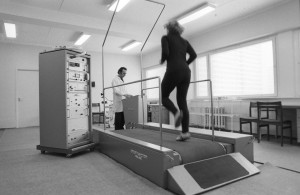 Gait impairment in Parkinson’s disease (PD) patients is characterized by the inability to generate appropriate stride length. Treadmill training has been proposed as a therapeutic tool for PD patients. However, it remains unknown whether treadmill training effects are different from overground walking training. A recent study in Gait and Posture has demonstrated that treadmill training programs improve preferred speed walking, lead to an improvement in the stride length and improve TUG and balance in PD patients.
Gait impairment in Parkinson’s disease (PD) patients is characterized by the inability to generate appropriate stride length. Treadmill training has been proposed as a therapeutic tool for PD patients. However, it remains unknown whether treadmill training effects are different from overground walking training. A recent study in Gait and Posture has demonstrated that treadmill training programs improve preferred speed walking, lead to an improvement in the stride length and improve TUG and balance in PD patients.
22 PD patients were randomly assigned to a treadmill or overground training group. The training program consisted of 5 weeks (3 sessions/week). Before and after the program we evaluated gait kinematics during walking at preferred and maximal speed; Timed Up and Go (TUG); static posturography and knee extensors strength. Gait parameters were reevaluated in the treadmill training group one month after the cessation of the training.
Preferred speed walking improved in both groups after the training program. The treadmill training program, but not the overground, led to an improvement in the stride length at the preferred and maximal walking speed in the PD patients. In addition, the treadmill training group showed improvement of the TUG and static posturography tests. The improvement in gait parameters was maintained one month after the cessation of the treadmill training.
This study provides evidence of a specific therapeutic effect of treadmill training on Parkinsonian gait and balance. Walking on a treadmill may be used as an easy, effective and accessible way to improve the stride length and balance in PD patients.
Help the APPDE build the Parkinsons Disease page in Physiopedia